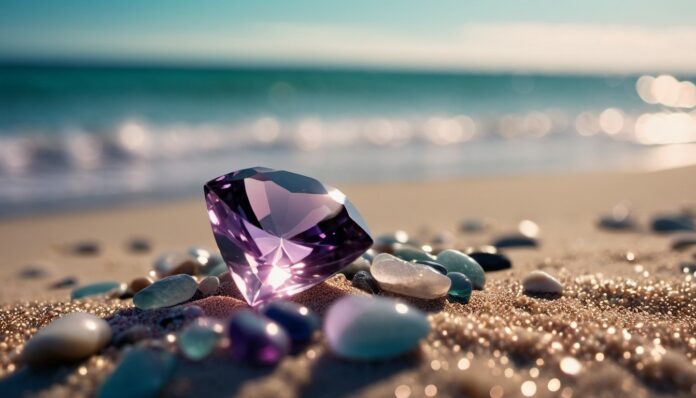Alexandrite is a rare and fascinating gemstone known for its unique color-changing properties. Discovered in the 19th century, this stone has captivated gem enthusiasts and collectors with its ability to shift colors under different lighting conditions. Alexandrite’s rarity and beauty make it one of the most sought-after gemstones in the world.
Discovery and History
Alexandrite was discovered in the Ural Mountains of Russia in the early 1830s. It was named after Tsar Alexander II because it was found on his birthday. The stone quickly became popular in Russia due to its stunning color-changing ability and was considered a symbol of good fortune.
Unique Color-Changing Properties
One of the most remarkable features of alexandrite is its ability to change color based on the lighting. In daylight, it appears green or bluish-green, while under incandescent light, it changes to red or purplish-red. This dramatic shift in color is due to the stone’s complex chemical composition and the way it absorbs light.
Formation and Composition
Alexandrite is a variety of the mineral chrysoberyl and contains trace amounts of chromium, which is responsible for its color-changing properties. It forms in a rare and complex geological environment, making high-quality alexandrite extremely rare and valuable.
Sources and Mining Locations
While the original source of alexandrite was the Ural Mountains, today it is also found in other parts of the world, including Brazil, Sri Lanka, and East Africa. Each location produces alexandrite with slightly different color characteristics, but the Russian stones are still considered the finest.
Symbolism and Meaning
Alexandrite is often associated with good luck and fortune. It is also believed to bring balance and clarity to its wearer. In metaphysical circles, alexandrite is thought to enhance creativity and inspire imagination, making it a favorite among artists and writers.
Healing Properties
Alexandrite is believed to have numerous healing properties. It is thought to:
- Boost Confidence: Help its wearer build self-esteem and confidence.
- Promote Emotional Healing: Aid in recovering from emotional trauma and providing emotional balance.
- Enhance Intuition: Improve perception and intuition, making it easier to navigate complex situations.
- Stimulate the Mind: Increase creativity, imagination, and mental clarity.
- Physical Healing: Assist in detoxifying the body and improving the nervous system.
Care and Maintenance
Alexandrite is a relatively hard gemstone, with a rating of 8.5 on the Mohs scale, but it still requires careful handling to avoid scratches and damage. It is best cleaned with warm, soapy water and a soft brush. Avoid exposing alexandrite jewelry to harsh chemicals or extreme temperatures.
Interesting Facts
- Alexandrite is often referred to as “emerald by day, ruby by night” because of its color-changing property.
- The stone was named in honor of Tsar Alexander II of Russia.
- It is one of the rarest gemstones in the world.
- Natural alexandrite is more valuable than synthetic versions.
- The color change in alexandrite is due to the presence of chromium.
- Alexandrite has a pleochroic nature, meaning it shows different colors when viewed from different angles.
- The finest alexandrite stones come from Russia.
- Alexandrite is also found in Brazil, Sri Lanka, and East Africa.
- It is the birthstone for June, alongside pearl and moonstone.
- Alexandrite is often used in high-end and custom jewelry.
- It is believed to help with emotional healing and balance.
- The largest faceted alexandrite weighs around 65.08 carats.
- Alexandrite was first discovered in the Ural Mountains in the 1830s.
- Synthetic alexandrite was first created in the 1960s.
- Alexandrite is used as a gemstone in various forms of jewelry, including rings, earrings, and pendants.
- The stone is prized for its rarity and unique color-changing properties.
- Alexandrite is relatively hard, with a Mohs hardness of 8.5.
- It is considered a symbol of prosperity and longevity in some cultures.
- High-quality alexandrite can command prices higher than diamonds.
- The Smithsonian Institution houses one of the finest alexandrite specimens.
- Alexandrite’s color change is best observed under natural daylight and incandescent light.
- The gem was a favorite among Russian royalty.
- Alexandrite is sometimes referred to as the “stone of balance” for its perceived metaphysical properties.
- In gemology, the phenomenon of color change in alexandrite is known as the “alexandrite effect.”
- Alexandrite can also exhibit a cat’s eye effect when cut en cabochon.
- The largest alexandrite crystal ever found weighed around 1876 carats.
- Alexandrite’s value significantly increases with the intensity of its color change.
- It is believed to enhance intuition and creativity.
- The stone is also associated with bringing joy and prosperity.
- Alexandrite continues to be a subject of fascination and admiration in the world of gemstones and jewelry.
*****
Alexandrite is a truly unique gemstone with its captivating color-changing properties and rich history. Whether you are a collector, a jewelry lover, or someone who appreciates rare and beautiful stones, alexandrite offers a fascinating glimpse into the natural world’s wonders. Its rarity and distinctiveness continue to make it a cherished gemstone across the globe.
